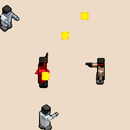Introduction: 2 Liter Rocket
Looking for something exciting to do? Try building a water powered rocket out of a 2 liter soda bottle! This can be completed in less than half an hour with simple household materials.
Materials:
- 1 Two liter bottle
- Cardboard
- Card stock (or construction paper)
- 1 Cork
- 1 Schrader needle (common on most bicycle pumps)
- Tape
Tools:
- Excato Knife
- Drill (or awl)
- Scissors
- Bike pump
- Marker (or pen)
Step 1: The Cork Stopper
Take a cork and stick it into the soda bottle's opening to make sure that it fits in snugly. The seal has to be tight, so if your cork doesn't fit either find a larger diameter cork, or wrap the cork with tape to increase the diameter.
Cut the cork shorter so that the Schrader needle is longer than the cork, the tip of the Schrader needle has an opening that needs to be exposed.
Step 2: Drill Into Cork
Drill into the center of the cork all the way through. If you don't have a drill you can punch through the cork with an awl or a nail. The important thing is that the drilled hole is smaller than the Schrader needle.
Push the Shrader needle through the drilled opening, then insert the cork into the mouth of the bottle.
Step 3: The Fins
To make the fins lie the bottle flat of its side and trace a fin shape with a marker. The fins should be about 2 inches wide at the base and 8 inches high, but you can make them any shape you like.
Cut the fins out with an Exacto knife or scissors.
Step 4: Tape Fins
With the mouth of the bottle pointing downwards, attach the fins with tape, equally spaced around the bottle. I had the fins act as a stand for the bottle rocket, placed at a height to allow enough clearance under the rocket to install the bike pump into the cork.
I used strong duct tape so the fins were sturdy and would hold in place after a few rocket launches.
Step 5: The Cone
To form the cone simply fold over the corner of a sheet of card stock or construction paper and continue rolling until you get a cone with a base that is roughly the same diameter of the bottom of the soda bottle. If it's a little larger you can trim the cone base with scissors.
Use tape to secure the cone shape, then more tape to connect the cone to the bottom of the soda bottle.
Your rocket is all ready to launch! Now is the time to decorate your rocket if you want with color or stickers.
Step 6: Take It Outside
Find a suitable launching site to blast off. I went to the park, but any open area away from trees and power lines will work.
Step 7: Fill With Water
Before hooking up the bike pump we'll need to add some water to the soda bottle. Since water doesn't compress, water will act as a ballast for the soda bottle and reduce the amount of area inside the bottle to be pressurized (which means less pumping).
I suggest filling about 10% with water, although, you can experiment and find what you think works best for your rocket.
Step 8: Pumping
Insert the cork stopper into the rocket, making sure the cork has a snug fit. Place your bike pump off to the side of the rocket and start pumping.
Make sure the rocket isn't pointed at anything, especially yourself!
Step 9: Blast Off!
Keep pumping, the soda bottle will pressurize and the rocket will blow out the cork and blast off!
I was able to get mine to go about 25ft high, but with experimentation on cork tightness and water ballast I'm sure you can get yours to go higher.
please share your soda bottle rocket in the comments below. Happy launching!













